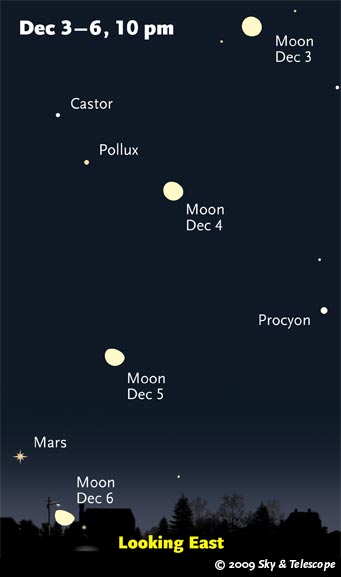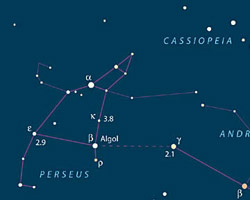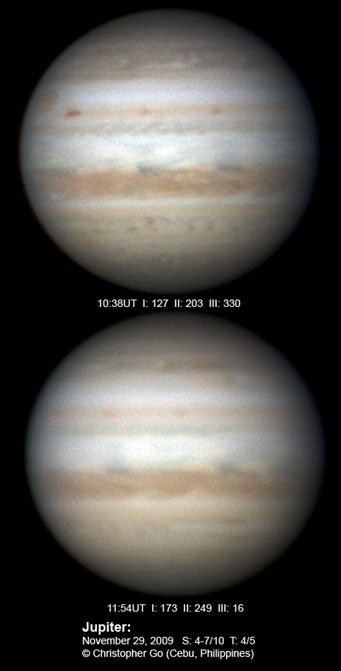Some daily events in the changing sky for November 27 – December 5.

As the Moon wanes away from full, watch it descend the late-evening sky on its way to meeting Mars. (This scene is drawn for the middle of North America. European observers: move each Moon symbol a quarter of the way toward the one for the previous date.)
Sky & Telescope diagram
Friday, November 27
Saturday, November 28
Sunday, November 29
Monday, November 30
Tuesday, December 1
Wednesday, December 2

Algol (Beta Persei) was the first eclipsing variable star discovered. Good comparison stars are Gamma Andromedae to Algol's west, magnitude 2.1, and Epsilon Persei to its east, magnitude 2.9. Click chart for larger view.
Thursday, December 3
(The minima-of-Algol times printed in the December S&T are incorrect. Use the times for December that are printed in the January issue, page 62.)
Friday, December 4
Saturday, December 5
Want to become a better amateur astronomer? Learn your way around the constellations. They're the key to locating everything fainter and deeper to hunt with binoculars or a telescope. For an easy-to-use constellation guide covering the whole evening sky, use the big monthly map in the center of each issue of Sky & Telescope, the essential magazine of astronomy. Or download our free Getting Started in Astronomy booklet (which only has bimonthly maps).
Sky Atlas 2000.0 (the color Deluxe Edition is shown here) plots 81,312 stars to magnitude 8.5. That includes most of the stars that you can see in a good finderscope, and typically one or two stars that will fall within a 50× telescope's field of view wherever you point. About 2,700 deep-sky objects to hunt are plotted among the stars.
Alan MacRobert
Once you get a telescope, to put it to good use you'll need a detailed, large-scale sky atlas (set of charts; the standards are Sky Atlas 2000.0 or the smaller Pocket Sky Atlas) and good deep-sky guidebooks (such as Sky Atlas 2000.0 Companion by Strong and Sinnott, the more detailed and descriptive Night Sky Observer's Guide by Kepple and Sanner, or the classic Burnham's Celestial Handbook). Read how to use them effectively.
Can a computerized telescope take their place? I don't think so — not for beginners, anyway (and especially not on mounts that are less than top-quality mechanically). As Terence Dickinson and Alan Dyer say in their Backyard Astronomer's Guide, "A full appreciation of the universe cannot come without developing the skills to find things in the sky and understanding how the sky works. This knowledge comes only by spending time under the stars with star maps in hand and a curious mind." Without these, "the sky never becomes a friendly place."
More beginners' tips: "How to Start Right in Astronomy".
This Week's Planet Roundup

Jupiter is getting smaller week by week as Earth pulls farther ahead of it in our orbit around the Sun. These images were taken by Christopher Go on November 29th. In the top image, the Great Red Spot is just about to rotate off the preceding (celestial western) limb. By the time of Go's second image, 1 hour 16 minutes later, Jupiter was lower in the sky and the seeing was much worse.
Note the four small, dark red spots following the Great Red Spot at nearly the same latitude. (The fourth is seen best in the bottom image, after Jupiter had rotated substantially.)
South is up. The South Equatorial Belt has faded greatly compared to the darker North Equatorial Belt. And its north and south components are now different colors!
Stacked-video images like these usually show much more detail than a planet will show to the eye through the same telescope.
Mercury is hiding deep in the sunset.
Venus (magnitude –3.9) is disappearing very low in the dawn. Look for it just above the east-southeast horizon 20 or 30 minutes before your local sunrise time.
Mars (magnitude 0.0, in easternmost Leo) rises around 9 or 10 p.m. local time, far below Castor and Pollux a bit north of east. It's very high in the south before dawn. In a telescope Mars is 10 arcseconds wide and growing. The planet's north polar cap is in good view this season, currently bordered by a wide, dark collar. Any other surface features? Clouds? See the Mars map and observing guide in the December Sky & Telescope, page 57. Mars is on its way to opposition late next January, when it will be 14.1 arcseconds wide.
Jupiter (magnitude –2.3, in Capricornus) shines brightly in the south-southwest in late twilight, and lower in the southwest later. It sets around 10 p.m. local time.
Saturn (magnitude +1.0, in the head of Virgo) rises around 1 or 2 a.m. and shines in the southeast before and during dawn. Its rings are still narrow, tilted only 4° from edge-on.
Uranus (magnitude 5.8, below the Circlet of Pisces) is highest in the south during early evening.
Neptune (magnitude 7.9, in Capricornus) lurks 3° east of Jupiter, which shines 12,000 times brighter. Nevertheless Neptune is detectable in good binoculars. Use our finder charts for both Uranus and Neptune.
Pluto is hidden behind the glare of the Sun.
All descriptions that relate to your horizon or zenith — including the words up, down, right, and left — are written for the world's mid-northern latitudes. Descriptions that also depend on longitude (mainly Moon positions) are for North America. Eastern Standard Time (EST) equals Universal Time (also known as UT, UTC, or GMT) minus 5 hours.
To be sure to get the current Sky at a Glance, bookmark this URL:
http://SkyandTelescope.com/observing/ataglance?1=1
If pictures fail to load, refresh the page. If they still fail to load, change the 1 at the end of the URL to any other character and try again.
 0
0
Comments
You must be logged in to post a comment.